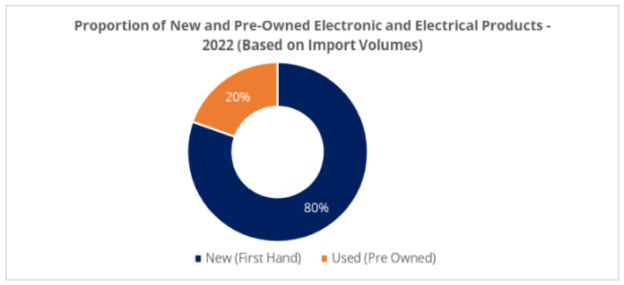The consumer electricals and electronics market stands as a dynamic and ever-evolving sector, reflecting the rapid advancements in technology and the growing demands of an increasingly connected world. The rapid pace of innovations in technology is driving demand for newer and improved electrical and electronic products. Simultaneously, the expanding middle class of individuals and businesses are constantly replacing or upgrading older products with more advanced versions which has contributed to the growth in the market. This article explores the multifaceted landscape of the industry with a focus on electrical products and electronics such as air conditioning machines, refrigerators, freezers, washing machines, irons, electric burners, food processors, microwaves, blenders, microphones, speakers, rice cookers and kettles.
Market Segmentation
The electrical and electronics markets can be broadly divided into two main segments: new (first-hand) and pre-owned (second-hand) sectors. The second-hand market is primarily characterized by pre-owned items from well-renowned and high-end brands such as Samsung, Philips, and Sony. Players in this market d
istribute varieties of preowned electronics and electricals sourced from several countries. Generally, in Accra, Lapaz is recognized as the central hub for the distribution and retailing of pre-owned electrical and electronic items.
Figure 1: Proportion of New and Old Electrical and Electronic Products, 2022

Source: Ministry of Trade, MOTI
Conversely, the new market comprises companies and enterprises specializing in the sale of brand-new electrical and electronic items as well as franchise dealers representing international brands. Currently, newly manufactured electrical and electronic products control about 80% share of the market.
A Demand Shift from Pre-Owned to New Electricals and Electronics
Until the late 2000s, demand for pre-owned electronics was the order of the day. The new electronics market at the time largely constituted so-called high-end brands that were too expensive for most consumers to purchase as brand-new. The limited presence of affordable brand-new options and the general notion among consumers that used electrical products were just as reliable as the new ones fueled this preference. Historically, consumer demand for electronic products was largely influenced by considerations of product quality and brand reputation irrespective of whether the products were new or pre-owned. Established brands such as Sony, Philips, and Kenwood were regarded as durable and long-lasting prompting consumers who couldn't afford new products from these brands to opt for pre-owned items over less popular brand-new alternatives.
Currently, demand for pre-owned electrical and electronic products is gradually declining. This trend is attributed to the fact that there are currently a lot of affordable brand-new electronic products in the market that are of competitive pricing and quality. Further, the influx of numerous new energy-efficient electrical products in the market at competitive prices with comparable quality to second-hand products has led to a heightened preference for new electrical and electronic products among consumers.
To view the article in full click here.
The content of this article is intended to provide a general guide to the subject matter. Specialist advice should be sought about your specific circumstances.


